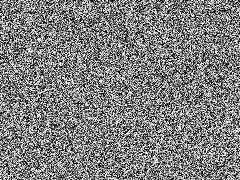White noise
File:White-noise-sound-20sec-mono-44100Hz.ogg
White noise is a type of noise that is produced by combining sounds of all different frequencies together. If you took all the tones that a human can hear and combined them, you would create white noise. The term "white" is used in a similar way to how it is used in the term "white light," which refers to a combination of all the different colors of light. In the context of sound, white noise is a constant, unchanging sound that can mask other sounds, making it useful in a variety of applications.
Characteristics[edit | edit source]
White noise has a specific characteristic in which each frequency is played at an equal intensity. This creates a "hissing" sound or a steady "shhh" that many people find soothing. It is often used to aid in sleep, to mask background noises, and in some cases, to help with concentration. The sound of white noise provides a kind of sound barrier that can help to minimize the distraction caused by other, more sudden noises.
Applications[edit | edit source]
White noise is utilized in various fields and for different purposes. Some of the common applications include:
- Sleep Aid: Many people use white noise machines or recordings to help block out disruptive noises while trying to sleep. It is particularly helpful for individuals living in noisy environments or for those who have trouble falling asleep.
- Tinnitus Management: White noise can help to mask the ringing in the ears experienced by individuals with tinnitus, providing some relief from the condition.
- Privacy: In offices and medical facilities, white noise generators can be used to enhance speech privacy. It makes it harder for conversations to be overheard by creating a masking sound.
- Concentration: Some individuals find that white noise helps to improve their concentration by masking distracting sounds, making it easier to focus on tasks.
- Audio Testing and Acoustics: White noise is used in the calibration of audio equipment and in acoustic testing due to its uniform spectral density.
Generation[edit | edit source]
White noise can be generated in several ways, including electronically through white noise machines, through specific apps designed for sleep or concentration, or naturally, such as the sound of rain, wind, or ocean waves. Technically, the natural sounds are often considered as "pink noise" or "brown noise" because they have different characteristics compared to pure white noise, which has a flat frequency spectrum.
Health Effects[edit | edit source]
The effects of white noise on health are mixed. Some studies suggest that using white noise can improve sleep quality and help with concentration. However, there is also research indicating that continuous exposure to white noise might affect hearing or even cognitive development in infants. Therefore, it is recommended to use white noise at a moderate volume and for specific purposes rather than continuous exposure.
See Also[edit | edit source]
| This article is a stub. You can help WikiMD by registering to expand it. |
Search WikiMD
Ad.Tired of being Overweight? Try W8MD's physician weight loss program.
Semaglutide (Ozempic / Wegovy and Tirzepatide (Mounjaro / Zepbound) available.
Advertise on WikiMD
|
WikiMD's Wellness Encyclopedia |
| Let Food Be Thy Medicine Medicine Thy Food - Hippocrates |
Translate this page: - East Asian
中文,
日本,
한국어,
South Asian
हिन्दी,
தமிழ்,
తెలుగు,
Urdu,
ಕನ್ನಡ,
Southeast Asian
Indonesian,
Vietnamese,
Thai,
မြန်မာဘာသာ,
বাংলা
European
español,
Deutsch,
français,
Greek,
português do Brasil,
polski,
română,
русский,
Nederlands,
norsk,
svenska,
suomi,
Italian
Middle Eastern & African
عربى,
Turkish,
Persian,
Hebrew,
Afrikaans,
isiZulu,
Kiswahili,
Other
Bulgarian,
Hungarian,
Czech,
Swedish,
മലയാളം,
मराठी,
ਪੰਜਾਬੀ,
ગુજરાતી,
Portuguese,
Ukrainian
Medical Disclaimer: WikiMD is not a substitute for professional medical advice. The information on WikiMD is provided as an information resource only, may be incorrect, outdated or misleading, and is not to be used or relied on for any diagnostic or treatment purposes. Please consult your health care provider before making any healthcare decisions or for guidance about a specific medical condition. WikiMD expressly disclaims responsibility, and shall have no liability, for any damages, loss, injury, or liability whatsoever suffered as a result of your reliance on the information contained in this site. By visiting this site you agree to the foregoing terms and conditions, which may from time to time be changed or supplemented by WikiMD. If you do not agree to the foregoing terms and conditions, you should not enter or use this site. See full disclaimer.
Credits:Most images are courtesy of Wikimedia commons, and templates, categories Wikipedia, licensed under CC BY SA or similar.
Contributors: Prab R. Tumpati, MD



